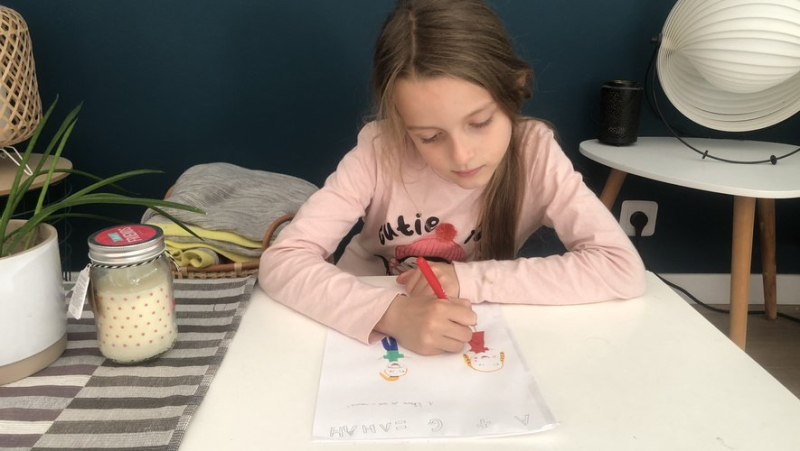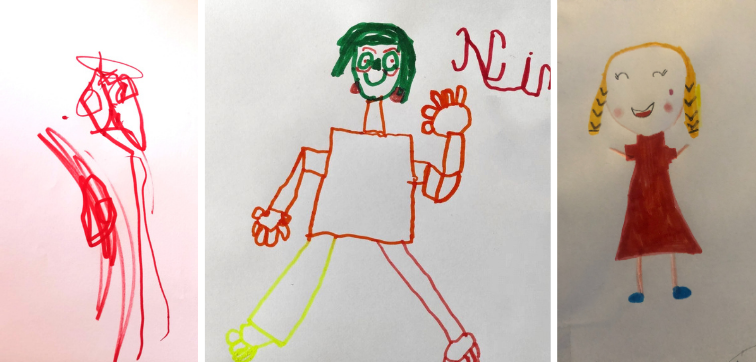“It’s probably the most interesting marker of its development”: what do children’s drawings tell us ?

Children's drawing is always expressive. -DR
"Children's drawing is an astonishing and complex continent", writes René Baldy from Montpellier, professor of psychology, in the book "100 ideas for knowing children's drawing", which has just been published in Tom Pousse editions. Sometimes used to assess the psychological health of a child, what do the first figures tell us, the doodles, the choice of a color?
René Baldy is honorary professor of child development psychology. He spent his entire career at Montpellier University Hospital. He has just published "100 ideas for knowing and understanding children's drawing" (18 euros) published by Tom Pousse.

René Baldy: “Do not try to interpret”.
What do children’s drawings tell us?
They mainly talk to us about child development. For me, drawing is perhaps the most interesting marker that allows parents to follow the psychological development of their child. The child progresses in terms of language, controls his emotions better, his personality evolves… but all that does not remain. The drawing evolves, and we can keep it.
What's interesting is to look at what changes as the child grows.
What are they not telling us ? You warn, I quote you, against the temptation to rsquo;trying to understand your child by looking at his drawings…
I am working on providing keys to understanding drawing. But understanding your child by looking at his drawings is for me an impossible task. It’s even dishonest to let parents believe that.
It would even be too intrusive?
All this refers to a psychoanalytic approach to drawing, a theory which is discussed today. Furthermore, interpreting a child's drawing psychoanalytically is work that requires at least five years of study from a psychologist, and some experience.
It’s already very complicated for a psychologist. For parents, this is completely illusory! He will project his anxieties into the interpretation he will make of his child's drawing, he risks "pathologizing" in a way, seeing problems where there are none. The children’s drawings are very rich. There are so many oversights, omissions, distortions in the interpretation…
Finally, indeed, as you say, it will distort the relationship with the child, it’s not healthy. I usually tell the parent that if their child has a “psychological” problem, they will see it quickly: he will not want to go to school, he won't eat, he won't sleep well, the teachers will alert… They don't need to interpret their child's drawings to realize that they have a problem. And if he doesn’t have one, you have to let him draw without distorting the relationship by interpreting the drawing using a psychoanalytic approach. This is inappropriate.
Psychologists and child psychiatrists make children draw…
They can make them draw for something other than to psychoanalytically interpret the drawing, to put it to use, to evaluate intellectual development… having a child draw a drawing is already, for a psychologist, a way of entering into a relationship with him, of making him talk, of seeing how he reacts…
Then, to directly answer the question, the psychoanalytic interpretation of the child's drawing strictly speaking is an approach that is not validated by science. "psychiatrists" say that it works but the scientific work that tries to validate the observations fails.
"The snowman is the drawing that lends itself best to monitoring the development of the child"
But the drawings of children who experience difficult things, attacks, a context of war… are nevertheless not trivial. A child who is not doing well, it doesn't show in his drawings?
A child who has no particular problem may draw violent drawings and a child who is aggressive or has behavioral problems may not. Take two groups of twenty children, with aggressive children in one of the groups, have them draw a man. Mix the 40 drawings and ask a psychologist to tell the difference. The choices made will be random.
I was interested in children's drawings during the war. When we look at them, it is very difficult to spot, with some exceptions, particular signs. They are not distinguished, in any case, by stable, identifiable characteristics which would unambiguously mean that the child has experienced war-related trauma.

The men of Anna-Rose, 2 years and 8 months, Nino, 5 and a half years old and Gabrielle, 8 years old. DR
So let's take a sexually assaulted child, one in ten…
The first idea that comes to mind is the presence of genitals in the drawing, they are rarely there in a child's drawing. But that's not enough.
Here too, if we take two groups of children including one with sexually assaulted children, we will not see any notable difference either.
You talked about the man, why is he central in a child’s drawing?
There are several answers. The first is that for a century, there have been several tests relating to the man among psychologists. It’s also one of the child’s favorite drawings. And it’s perhaps one of the earliest identified drawings. Finally, it is also one of the drawings that best lends itself to monitoring the child’s development.
The referent is universal, it is quite simple in its structure, circles, lines, but it is complex if we want to go into details. It’s a design that gradually evolves during development, which is why it is of great interest to psychologists.
"Facing the tablet, drawing has little chance"
A child wants to stick to reality or he knowingly abstracts?
The child wants to express an idea in his drawing. A child's drawing is always expressive, without intention, but there are currently studies on the clues that allow emotion to be expressed in drawing. There are omissions, proportions that are not respected, a signifier that will be enormous, fanciful colors… witches, dinosaurs… hellip; that he has never seen. His concern is not to imitate reality either. What he wants is to mean things. And for this it relies on graphic models. We see it with the sun: the child does not reproduce the sun as he sees it.
Or something else: a child who lives in a building will not necessarily draw buildings. Or, it will be based on the model of the house, with a triangle for the roof, a rectangle…
The invasion of screens changes something in the relationship to drawing?
Facing the tablet, drawing has little chance.
This is a problem?
This is both a problem and a solution. This is the problem with screens… The use of screens establishes skills that contradict those expected for drawing. On the screen, thinking is rapid, the child is guided, there is little attention, it's zapping. On the contrary, for drawing, slow, sustained reflection is required, from memory… the children say that drawing doesn't go fast enough!
At the same time, it is possible that in a few decades paper/pencil drawing will be completely replaced by the stylus graphics tablet device.
"Children would draw better if parents gave the same importance to drawing as to language"
However, we must not miss this phase of drawing in the development of the child…
It's best not to miss it. The child develops himself by drawing, penetrates his culture, discovers graphic signifiers, exercises his motor skills, forms his aesthetic taste…
A child who draws well will more likely learn to write than another.
And a child who draws badly or doesn't know how to draw, it's serious?
In our culture, we value speech. Probably children would draw better if parents gave drawing the same importance as language.
Why do children stop drawing around the age of 10-11?
This is the case for 95% of children, there are still 5% who are very motivated…hellip; From the age of 10-11, the child enters a period where his intelligence becomes more abstract, he has more desire to read or write than to draw, upon returning to middle school, he has to ;other sources of interest which distract him from drawing.
There is also cultural pressure: what was valued in young children is no longer valued.
And finally, the child becomes more demanding when it comes to his drawings, and to achieve this, you need skills, you have to learn, you have to make an effort. Generally, neither parents, nor school, nor society provide him with the conditions for this.
I subscribe to read more




